 When it comes to constructing a portfolio, I used to think it was all about numbers and optimization. When you pick an asset class based on historical data, that assumes you hold through both the good times and the really bad times. It has helped me to keep gathering nuggets of knowledge over time to maintain my faith during those really bad times.
When it comes to constructing a portfolio, I used to think it was all about numbers and optimization. When you pick an asset class based on historical data, that assumes you hold through both the good times and the really bad times. It has helped me to keep gathering nuggets of knowledge over time to maintain my faith during those really bad times.
I’d like to start a series of posts to document why I own each specific asset class. Somebody asked me about TIPS the other day, so I’ll start with them. I’m not an investing professional, just a semi-retired DIY investor who wants to keep on learning and would like to share with other like-minded folks. I won’t get into the tiny details, mostly a lot of charts, links, and higher-level ramblings.
Treasury Inflation-Protected Securities (TIPS) are bonds issued by the US government that pay interest which is linked to inflation. Inflation is measured by the . In terms of a useful all-around primer, this Morningstar (M*) article covers a lot of the bases. For more nuts-and-bolts mechanics, see this older Vanguard paper . According to M*, TIPS currently make up about 9% of the overall Treasury market.
Here are my reasons for owning Treasury Inflation-Protected Securities (TIPS):
TIPS are backed by the US Government, just like the more common “vanilla” US Treasury bonds. With bonds, I prefer to stay on the safer end of the spectrum. Bonds are debt, and I don’t want to worry about if I get paid back. Buying US Treasury bonds is the lowest amount of credit risk possible.
TIPS provide a “real” inflation rate at purchase, which means it is guaranteed to provide a set return above inflation (before taxes) until maturity. Very few bonds are structured in this manner. In simplified terms, if the real interest rate is 2% and inflation is 3%, then the total interest paid will be 5%. Working backwards from that, you get the concept of breakeven inflation rate, or the expected inflation by the market (via M*):
The introduction of TIPS brought with it a market-determined observable real rate of interest, which is what the yield on a TIPS is. If you subtract the TIPS yield from the comparable-maturity nominal Treasury yield, you get the market’s inflation expectation over the period until maturity of these two bonds. This is called “breakeven inflation,” because it is the level of inflation at which returns for the nominal and inflation-indexed bonds should break even.
Here’s how the expected inflation and actual inflation compared for 5-year periods since 2003. For the most part, they have been pretty close:
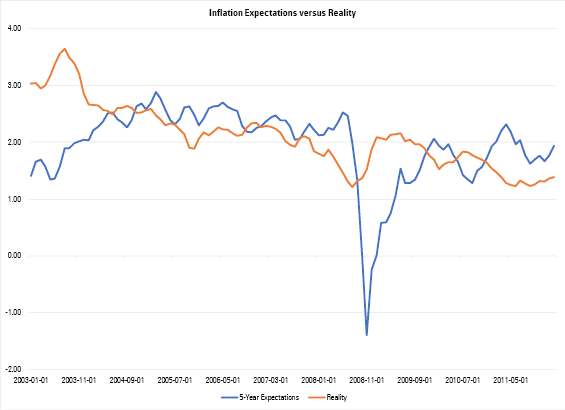
TIPS thus provides insurance against *unexpected* inflation. TIPS are often described as an inflation hedge, but it’s more of a hedge against unexpected inflation. All bonds are already priced with inflation in mind. If everyone thinks inflation will be high, then bonds across the board will be priced to pay out more interest to counter that.
The reason why you don’t hear much about TIPS in the media is that over the last several years, there hasn’t been any unexpected inflation. If you bought fire insurance on your house, and your house hasn’t burned down yet, are you going to stop buying the fire insurance?
TIPS also provides a certain amount of protection in case of severe deflation. TIPS are guaranteed to return par at maturity, meaning they have floor value even in a case of severe deflation. This asymmetry helps make TIPS attractive relative to Treasuries, as best explained by this :
Thus, assuming a view that an inflationary and deflationary scenario are equally likely, the unlimited potential outperformance of TIPS vs. Treasuries in an inflationary environment and limited upside of Treasuries vs. TIPS in a deflation environment would sway an investor towards TIPS.
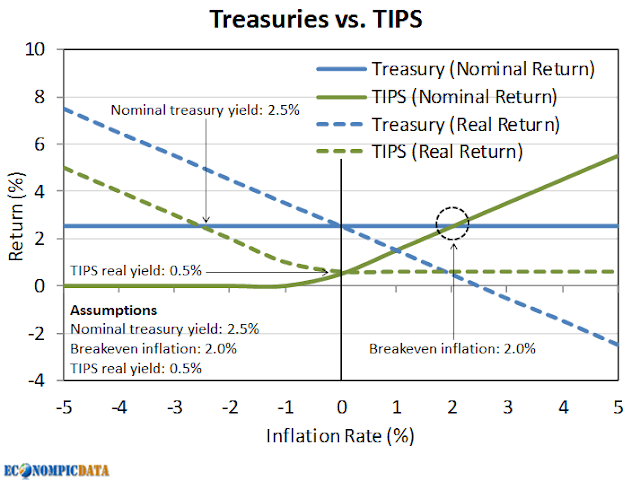
If inflation meets the market expectations, then TIPS and Treasuries will have the same return. If actual inflation is higher than the (expected) breakeven inflation rate, then TIPS will pay more than the regular Treasury bond. If actual inflation is less than the (expected) breakeven inflation rate, then TIPS will pay less than the regular Treasury bond. Here’s a simple graphic from :
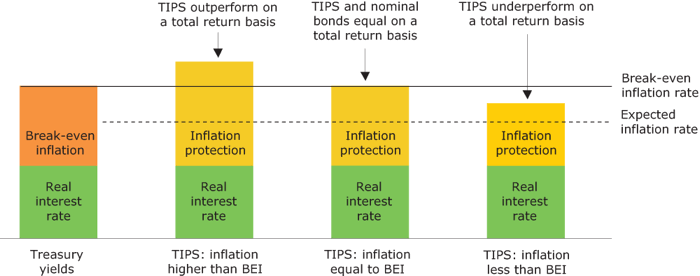
Here’s a 2008-2018 Morningstar chart comparing the growth of $10,000 between the Vanguard Intermediate Treasury Fund (VFITX) and the Vanguard Inflation-Protected Securities Fund (VIPSX). You can see while there is definitely a difference – sometimes one leads, sometimes the other – but over the last 10 years the net return has been very similar. Again, inflation has not been much higher (or a lot lower) than expected.
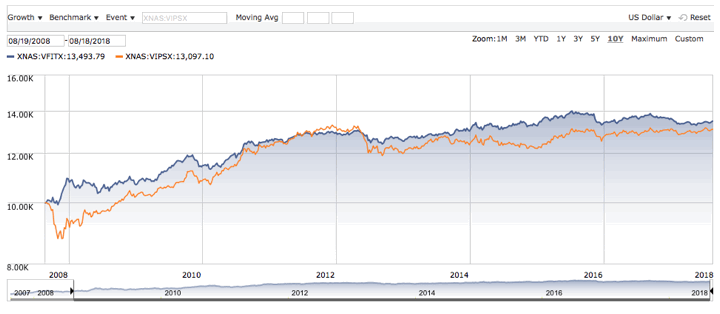
Do you think future inflation will be higher than the current expected number? Here’s the 5-year breakeven inflation rate for the last couple of years. Via .
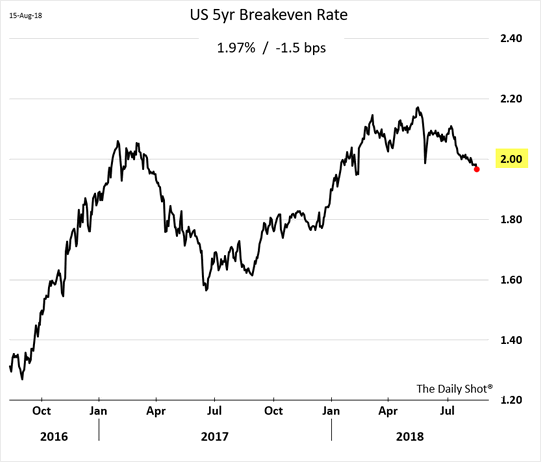
If I had to bet, I would bet that the future inflation number will be higher than 2% then less than 2%. However, most likely they will return around the same amount. So this is not a huge risky bet. In terms of the big picture, it’s a relatively wimpy bet. I currently hold about 1/3rd of my in bonds, and about 1/3rd of those bonds are invested in TIPS. That means about 11% of my total portfolio is in TIPS. If the real yields on TIPS were to go back higher to historical levels, I would go back up to 50% of bonds in TIPS.
Here are some reasons for NOT owning Treasury Inflation-Protected Securities (TIPS). TIPS are not part of the efficient frontier. If you run an mean-variance blah-blah-blah optimizer, you won’t find TIPS on the ideal risk/return curve. TIPS have a low historical correlation with stocks, but not as low as regular Treasuries – . TIPS have only been around for 20 years. TIPS interest is taxed at ordinary income rates every year, and are thus generally recommended to be kept in tax-sheltered accounts. (TIPS interest is exempt from state and local taxes, however.) Finally, some people worry that the government will fudge the CPI numbers if high unexpected inflation really becomes a problem.
from .
© MyMoneyBlog.com, 2018.